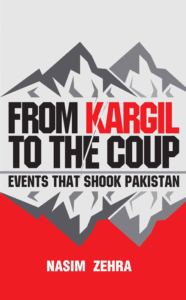Book Review: From Kargil to the Coup
By Imtiaz Gul | Bookmark | Published 7 years ago


Nasim Zehra
Did the fighters land from the heavens or were they parachuted from the air onto the Kargil peaks, quipped the then German ambassador to Pakistan, Hans Joachim Daerr, when his attention was drawn to the Pakistan military’s claims that Kargil was actually the work of the Kashmir mujahideen. The ambassador scoffed at the claims and demanded to know how the fighters managed to cross the Line of Control (LoC) and reach peaks that appeared extremely difficult to access without elaborate supply and communication lines.
The Kargil conflict, in the summer of 1999, undoubtedly helped the Indian government and their armed forces to craft a new narrative on Pakistan. And the Mumbai carnage, in November 2008, virtually cemented the anti-Pakistan sentiment and emboldened the Indian right to go belligerent on Pakistan. The trio of Narendra Modi, Amit Shah and Ajit Doval, the ultra-nationalistic national security advisor, carried the belligerence to new heights. As if that were not enough, Kulbushan Jadhav, the Indian spy, landed in Pakistan’s lap in March 2016. This catch lent an altogether different dimension to the Indo-Pak relations and, at least for some time, put the Indians on the defensive. What ensued was an obvious overt posturing and deliberate covert efforts to marginalise Pakistan wherever possible.
From Kargil to the Coup: Events that shook Pakistan, written by friend and journalist Nasim Zehra, encapsulates the contradictions, the falsehoods, the imprudent policies and the absence of any long-term vision behind the Kargil operation. The book draws heavily on the author’s excellent personal contacts and access to those who matter in Pakistan’s power matrix, both in the military and the civilian power houses. Consequently, it offers an authentic wealth of knowledge on how Operation Koh Paima (OKP) evolved and eventually left many, in and outside the country, befuddled.
The book details incisively this reckless operation that the ‘Kargil Clique,’ led by the army chief General Pervez Musharraf, and including Generals Javed Hassan and Aziz Khan, imposed on the army and the country. The hasty withdrawal agreement that the then prime minister, Nawaz Sharif, signed in Washington on July 4, says Ms Zehra, generated internal pressures on the army’s top brass for the simple reason that until early July, the ISPR (Inter-Services Public Relations) had insisted that the “mujahideen” were holding on to the peaks in Kargil and Dras and that there had been no reversals.
Being privy to much of what she has recounted in this brilliant book, Zehra has made a brave attempt to revisit our chequered Kashmir-related history that has, over the years, taken Pakistan down a disastrous path. The ambitious craving for wresting Srinagar from India not only gave birth to the jihadi industry inside Pakistan, but also singled it out as a country that abetted militancy as an instrument of foreign policy.
A number of people we met in Skardu in late July in the aftermath of the Kargil operation, were extremely upset and asked why the military and the government were crediting the Kashmiri mujahideen with the Kargil Operation? “We have lost our sons who had been drafted into the Northern Light Infantry (NLI), hundreds of them, but the government is not owning them anymore,” the anguished residents pointed out.
Coincidentally, we also bumped into a couple of officers from Rawalpindi. They were on an assessment mission, to gauge the extent of human loss the NLI had suffered. At times, they met with resentment and angry protests as they approached aggrieved families for collecting data on those lost during and in the aftermath of the withdrawal agreement Sharif signed with Bill Clinton in Washington on July 4.
We were told that at least 400 NLI soldiers had lost their lives, though for several days the media resonated with stories of the valiant efforts put up by the Kashmiri mujahideen. These claims were true only to the extent, one would assume, that some of the mujahideen outfits did help out in establishing the supply chain and initial reconnaissance.
Coincidentally, during our visits to Skardu and the craggy Kargil mountains, we stumbled, by chance, upon the rag-tag officers of at least two Kashmir-focused mujahideen outfits. They had been camping in Skardu since the mid-1990s.
One of the Lashkar-e-Tayyaba (LeT) commanders I knew from my interactions in Islamabad, Allah Wasaya, happened to be in Skardu too. He later died in the US bombings on Taliban targets in Kabul in October 2001. I also met an Al-Badr commander, who claimed to have helped in the Kargil Operation.
Since the July 4 agreement did not offer “safe-passage” to the holed-up, helpless NLI soldiers the Indians took advantage of the retreat and began pounding them.
The author bemoans the fact that despite the poor performance of the clique of commanders behind the OKP, “the power equation, the absence of any accountability, the absence of course when it mattered, and (unnecessary) bravado minus logic or sound analysis, have ruled the day. Despite repeated blunders, the commanders in charge escaped accountability.”
The major reason for the lack of accountability, she insists, is the country’s uneasy relations with India and the US, the external pressure dynamics, and the internal civil-military discord.
Zehra also contextualises why and how the Pakistan army had “planned its operations with faulty calculations, disregarding inter-state, regional and international implications… Their (Pak military) own Kashmir-centric security paradigm, India’s mostly recalcitrant mindset… the series of covert operations conducted against each other by two neighbours, India’s systematic role in being a midwife to the 1971 break-up of Pakistan, and the dynamics of distrust dominating the civil-military relations within Pakistan” are the factors that have weighed heavily both sides of the border, says the author.
Nasim Zehra rightly talks about the anguish that people within the army and outside felt over the contradictory claims and the hasty withdrawal from Kargil. If you ever needed an incisive account on the Kargil conflict, Nasim Zehra has delivered it. She rightly picked OKP to reveal the facts behind it “to a people who, in the past too, have had to pay heavily for serious policy blunders of Pakistan’s policy-makers, including the ultimate price of the country’s break-up.”
Kargil has practically sanctified the Line of Control — at least until both Pakistan and India close the Kashmir dispute in a mutually agreeable way — and, of course, to the satisfaction of the Kashmiris. If OKP was supposed to avenge the loss of key Siachen areas to India, it was also expected to draw international attention and support for the Kashmiris. But, as Nasim points out, little thought had gone into the expected fall-out. Would the Pakistani troops be able to hold on to their positions despite international calls for withdrawal? Would the government be able to handle the global, US-led, adverse reaction to it. And how would the reality that the occupants of Kargil and Dras were actually the Pakistan army — and not the Kashmiri mujahideen — play across the globe?
Given the richness of its primary literature, i.e. the interviews with the key stakeholders, From Kargil to the Coup is literally the A to Z of the Kargil Operation and holds a mirror to the complexities of Pakistan’s foreign policy. It offers much more than what Durrani (in The Spy Chronicles) and Sharif (in his Dawn interview) “revealed” and walks us through the genesis of the conflict as well lays bare, piece by piece, the “tactical brilliance of the planners of Kargil OKP,” as well as the strategic poverty of the “suicidal blunder” of Generals Musharraf, Aziz Khan and Javed Hassan.


